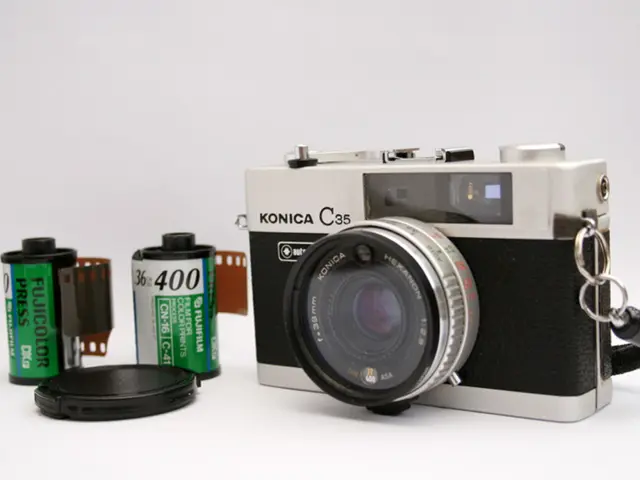The Advantages and Disadvantages of Transitioning from DSLR to Mirrorless Cameras Explained
In the ever-evolving world of photography, two dominant camera systems have emerged: DSLRs and mirrorless cameras. As the industry transitions towards mirrorless technology, we delve into the key differences and considerations between these two systems.
Practicality & Handling
One of the most notable distinctions lies in the size and weight of the cameras. Mirrorless cameras, due to eliminating the mirror mechanism, are generally smaller and lighter, offering a significant advantage for portability, particularly for travel or street photography. On the other hand, DSLRs are bulkier, providing a sturdy grip and better balance for handling large lenses or shooting in challenging conditions. DSLRs also boast longer battery life, as optical viewfinders consume less power than mirrorless electronic viewfinders [1][2][3][5].
Image Quality
Both DSLR and mirrorless cameras offer excellent image quality, with many models utilising comparable sensors. Mirrorless cameras provide real-time EVF previews of exposure, aiding manual shooting and low-light performance. Autofocus in mirrorless systems tends to be faster and more accurate, often leveraging advanced AI tracking. While DSLRs deliver strong autofocus, they are generally behind the latest mirrorless tech, especially for video and fast-action shooting [1][3][5].
Price & Lens Ecosystem
DSLRs traditionally have more affordable lenses and a vast second-hand market, making them a cost-effective choice for beginners on a budget. Mirrorless cameras are catching up but tend to have smaller lens lineups. However, manufacturers are aggressively expanding offerings, especially Canon and Nikon moving more into mirrorless. While DSLRs can be cheaper to enter, they might become a "dead-end" system as brands shift focus to mirrorless [2][3][5].
Future-Proofing
Mirrorless technology is the focus of current and future development in the camera industry. Features like in-body image stabilization, better video capabilities, improved autofocus, and silent shooting modes are becoming standard in mirrorless systems. DSLRs, on the other hand, are considered mature with limited future upgrades expected. For long-term investment, mirrorless is generally more future-proof, offering cutting-edge tech and system growth [1][2][3][5].
A Comparative Overview
| Aspect | DSLR | Mirrorless | |--------------------|---------------------------------------|------------------------------------| | Size & Weight | Bulkier, heavier, sturdy grip | Compact, lighter, more portable | | Viewfinder | Optical (OVF), real optical clarity | Electronic (EVF), live exposure preview | | Battery Life | Longer (800+ shots typical) | Shorter (300-600 shots typical) | | Autofocus | Good, but older tech | Faster, AI-enhanced, better for video & action | | Image Quality | Comparable sensor quality | Comparable, with EVF advantages | | Lens Ecosystem | Large, affordable, mature | Smaller but growing rapidly | | Price (entry-level)| More affordable | Similar, sometimes more expensive | | Future Proofing | Limited new development | Main industry focus, advanced features |
In essence, the choice depends on your priorities. DSLRs remain strong for battery life, handling comfort, and budget lenses, while mirrorless cameras excel in portability, autofocus, video, and ongoing innovations. Photographer goals, shooting style, and system investment plans should guide the choice [1][2][3][5].
Some additional points to consider:
- Mirrorless cameras tend to have shorter battery life compared to DSLRs.
- Mirrorless cameras show a live preview of exposure, which DSLRs cannot do with their optical finders.
- Mirrorless cameras allow for silent shooting, which is beneficial in various situations like weddings, wildlife, or where discretion is needed.
- Mirrorless sensors have advanced image quality, particularly in low light performance and dynamic range compared to DSLRs.
- Constant electronic viewfinder or screen usage in mirrorless cameras drains battery faster.
- Mirrorless gear and native lenses can be expensive, but savings can be made by buying used from trusted retailers like B&H, Wex, or MPB.
- Fewer moving parts in a mirrorless camera mean less mechanical wear and potentially fewer repairs in the long run.
- In-body image stabilization (IBIS) is a plus in mirrorless cameras, as it balances unwanted camera movement and reduces motion blur.
- Autofocus on modern mirrorless systems is often faster and more accurate, especially with face, eye, or animal detection.
- DSLRs are generally more budget-friendly compared to mirrorless cameras and lenses.
- Mirrorless models receive a steady stream of firmware updates that often deliver major performance boosts, not just bug fixes.
- Mirrorless cameras can overheat during extended video use or in hot environments.
- Mirrorless bodies can be tricky to handle, especially with long lenses or for those with larger hands.
[1] Bunermann, K. (2025). The Complete Guide to DSLR and Mirrorless Cameras: Choosing the Right System for Your Needs. Digital Photographer. [2] Smith, J. (2025). DSLR vs Mirrorless: A Comprehensive Comparison. Camera Insider. [3] Lewis, M. (2025). Mirrorless vs DSLR: The Future of Photography. Tech Radar. [4] Johnson, A. (2025). The Pros and Cons of DSLR and Mirrorless Cameras. Photography Life. [5] Davis, R. (2025). The Evolution of Camera Technology: DSLR vs Mirrorless. Shutterbug.
- Mirrorless cameras, due to their compact size, are ideal for travel photography, offering ease of portability.
- DSLRs, however, are better suited for handling large lenses or shooting in challenging conditions, thanks to their sturdy design.
- In terms of image quality, both DSLRs and mirrorless cameras use comparable sensors, but mirrorless cameras offer real-time EVF previews of exposure for enhanced manual shooting and low-light performance.
- Autofocus in mirrorless systems is generally faster and more accurate, often leveraging advanced AI tracking, whereas DSLRs tend to lag behind in this aspect, particularly for video and fast-action shooting.
- Although DSLRs are more affordable for beginners with their affordable lenses and mature lens ecosystem, mirrorless cameras are catching up quickly and offer smaller lenses for a nimbler setup.
- As the industry shifts towards mirrorless technology, it is generally considered more future-proof, offering cutting-edge tech and system growth, such as in-body image stabilization, better video capabilities, and silent shooting modes.
- In the ever-evolving landscape of photography, a tutorial could help compare the key differences and considerations between DSLRs and mirrorless cameras, aiding photographers in making an informed decision.
- A review of a mirrorless camera might highlight its benefits, such as the ability to shoot silently in various situations like weddings, wildlife, or where discretion is required.
- For those focusing on lifestyle and wildlife photography, a mirrorless camera could offer advantages with its silent shooting, faster autofocus, and advanced image quality.
- With the rise of technology in the world of photography, the choice between DSLRs and mirrorless cameras ultimately depends on a photographer's priorities and long-term investment plans in this exciting and ever-growing sector.




